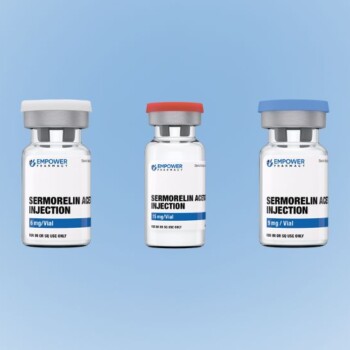Article Summary
Discover the role of Human Chorionic Gonadotropin (HCG) in hormone therapy, including its general aspects, solutions, and mechanism of action. Explore how HCG regulates hormone levels to support the health of both men and women.HCG General Information
Human chorionic gonadotropin (HCG) is used as a hormonal therapy to utilize the effects of pituitary-derived endogenous gonadotropins, including luteinizing hormone (LH) and follicle stimulating hormone (FSH).
HCG is a glycoprotein composed of 237 amino acids.[1] HCG is similar in structure and function to LH, and is thus prescribed by many physicians to mimic many of the physiological effects of LH. The reason that HCG is prescribed over LH is due to HCG’s more stable nature, greater physiological activity and longer circulating half-life. HCG has a half-life in the range of hours while LH has a half-life in the range of minutes. The half-life of LH is physiologically important and allows for pulsatile LH systemic exposure. HCG’s half-life and higher binding affinity for the mutual receptor ultimately allows it to be more biologically active than LH.[2][3]
LH and HCG are widely regarded as analogous hormones due to the similarity in the structure of the hormones, including the similar alpha subunits which exhibit similar biologic activities when associated with the beta subunit.[4] Furthermore, the HCG alpha subunit is identical to that of LH, FSH, and thyroid-stimulating hormone (TSH). The beta subunit is unique to HCG.
LH and HCG share a mutual receptor, however events after receptor binding are different between the two hormones.[5]
Human chorionic gonadotropin (HCG) and a recombinant formulation, called choriogonadotropin alfa (r-HCG), is a gonad-stimulating polypeptide hormone normally secreted by the placenta during pregnancy. The non-recombinant products are obtained from the urine of pregnant women. Recombinant-HCG is produced via recombinant DNA techniques in Chinese Hamster Ovary (CHO) cells. The pharmacological actions of HCG and of r-HCG are similar and resemble those of luteinizing hormone (LH); HCG is generally used as a substitute for LH.
HCG Treatments
HCG has been used to treat cryptorchidism or hypogonadotropic hypogonadism in males, sometimes in combination with menotropins or follitropin. Interestingly, HCG was introduced for the treatment of cryptorchidism in 1931, and remained the only hormonal agent available to treat the condition until the 1970’s, when gonadotropin-releasing hormone (GnRH) analogs also became a treatment option.
Urine-derived HCG was first approved by the FDA in 1939 and received subsequent approval for additional indications in 1973. Ovidrel®, the first recombinant HCG (r-HCG), received FDA approval for female infertility to induce final follicular maturation on September 20, 2000. Ovidrel® pre-filled syringes received FDA approval in October 2003; manufacturing of Ovidrel® vials has ceased.
HCG Mechanism of Action
The mechanism of action of human chorionic gonadotropin (HCG) depends upon the purpose for which it is being used, the sex of the patient, and the level of maturity of the patient to whom it is administered.
HCG in Adult and Adolescent Males
In adult and adolescent men with hypogonadotropic hypogonadism, HCG acts like LH and stimulates testosterone production in the Leydig cells and spermatogenesis in the seminiferous tubules. Stimulation of androgen production by HCG causes development of secondary sex characteristics in males (e.g., deepening of voice, facial hair, etc.). Human chorionic gonadotropin (HCG) also stimulates the Leydig cells to produce estrogens; increased estrogen levels may produce gynecomastia in some males. Once HCG is initiated, it takes at least 70—80 days for germ cells to reach the spermatozoal stage. Response to treatment is also noted by the development of masculine features and the normalization of serum testosterone levels. Induction of testicular growth and increased sperm volumes may help to restore fertility in these men after many months to years of treatment, which is then sometimes combined with the use of either menotropins or follitropin.
HCG in Adult Females & Infertility
In select females with infertility, human chorionic gonadotropin has actions essentially identical to those of luteinizing hormone (LH). Human chorionic gonadotropin (HCG) also appears to have additional, though minimal, follicle-stimulating hormone (FSH) activity. By administering HCG after follitropin, menotropins, or clomiphene, the normal LH surge that precedes ovulation can be mimicked. Human chorionic gonadotropin (HCG) promotes the development and maintenance of the corpus lutetium and the production of progesterone. Following HCG administration, final luteinization or maturation of the oocytes occurs and either ovulation can ensue for timed insemination techniques, or oocyte retrieval can take place for assisted reproductive technology (ART) procedures such as in vitro fertilization (IVF). Once pregnancy takes place, endogenous HCG is normally secreted by the placenta to support the continued secretion of female hormones and the corpus luteum.
HCG in Male Infants and Children
In the male infant, normal testicular descent is complete by 3 months of age. Testicular descent occurs secondary to an endogenous testosterone surge stimulated by pituitary gonadotropins in response to the discontinued exposure to maternal circulating estrogens upon birth; this testosterone surge peaks within 60 days postnatally. In male infants and children with cryptorchidism, HCG acts like LH and causes the Leydig cells of the testes to produce a testosterone surge and induce the descent of palpable testes. The hormonal stimulation by HCG may result in an early pseudopuberty, and in some cases, the response to hormonal therapy may be temporary in 10—20% of cases. Hormonal therapies like HCG have not replaced the primary surgical treatment for the condition, which is orchiopexy within the first 1—2 years of life. Early animal studies have suggested that HCG may be used as an adjunct to orchiopexy to help preserve fertility, but human data is lacking.
Activity on Body Composition (All Sexes)
Human chorionic gonadotropin has no known effects on appetite, or on mobilization or distribution of body fat. It is not an effective treatment for obesity. In sport, athletes use HCG as an ‘undetectable’ anabolic steroid; HCG increases the body’s production of testosterone and epitestosterone without increasing the ratio of the two hormones in the urine above normal values. Urinary testing is being developed which should allow for discriminate testing of HCG doping in sport.
HCG in Testosterone Replacement Therapy
HCG binds to receptors that are present in reproductive tissues in the male, regulating fertility. HCG is increasingly used in combination with Testosterone Therapy. When exogenous Testosterone is administered it influences the balance of the hypothalamus – pituitary – gonadal (HPG) axis. Due to the testosterone’s aromatization into estrogenic metabolites and direct androgenic effects, endogenous testosterone production is down regulated.
Estrogenic and androgenic mediated negative feedback reduces the secretion and activity of gonadotropin releasing hormone (GnRH) and therefore reduces gonadotropin secretion. Gonadotropins control the functionality of the gonads, including their production of hormones and physiological processes. More specifically, the reduction in LH and FSH activity reduce testicular spermatogenesis and testicular produced testosterone. Testicular atrophy is resultant of insufficient gonadotropin signaling. HCG is commonly used during and after testosterone therapy to maintain and restore testicular size, endogenous testosterone production and spermatogenesis.
HCG administration acts as supplemental gonadotropin, replacing absent LH activity. HCG stimulates the Leydig cells to synthesize intratesticular testosterone, this testosterone is essential for spermatogenesis occurring in the Sertoli cells.
During testosterone therapy HCG has been found to maintain the level of intratesticular testosterone and maintain normal spermatogenesis. To achieve this effect 500 IUs of HCG were administered every other day during testosterone therapy.[6][7]
In idiopathic hypogonadotrophic hypogonadism patients, ranging in age from 12 to 24, HCG (1,500-2,000 IU) was administrated intramuscularly, 3 times per week, for 8 weeks. The HCG treatment increased the serum testosterone level, penile length, and testicular volume in idiopathic hypogonadotrophic hypogonadism patients.[8] An increase in Penile length by HCG treatment has been shown. HCG Regulation of Hypothalamus – Pituitary – Gonad Axis (HPG) in Males.[9]
Tissues Involved in the Male HPG Axis:
- Hypothalamus – produces Gonadotropin Releasing Hormone (GnRH).
- Pituitary – produces gonadotropins luteinizing hormone (LH) and follicle stimulating hormone (FSH).
- Testes – contains Leydig cells and Sertoli cells. Produces testosterone which is metabolized into a cascade of metabolites most importantly including estrogen and progesterone. Facilitates spermatogenesis.
Hormones Involved in the HPG Axis:
- Gonadotropin Releasing Hormone (GnRH) – signals the pituitary to release FSH and LH in a pulsatile fashion.
- Luteinizing Hormone (LH) – binds with receptors on Leydig cells and interstitial cells in the testis, and promote the secretion of androgens by the Leydig cells.
- Follicle Stimulating Hormone (FSH) – binds with Sertoli cells which build the microenvironment of spermatogenesis, regulates the maturation of sperm cells.
- Estrogen – estrogen receptors in the hypothalamus and these receptors direct the negative feedback of GnRH secretion, negatively regulate at a pituitary level and gonadal cell level in an autocrine manner.
- Androgens- androgen receptors in the hypothalamus direct the negative feedback of GnRH secretion, regulate hormonal synthesis at gonadal cell level in an autocrine manner.
- Androgens have strong suppressive effects on gonadotropin synthesis in the anterior pituitary. Progesterone- negatively regulates the organizing hormone synthesis.
- HCG – mimics the functions of LH.
- Lapthorn, A.J., et al., Crystal structure of human chorionic gonadotropin. Nature, 1994. 369(6480): p. 455-61.
- Rahman, N.A. and C.V. Rao, Recent progress in luteinizing hormone/human chorionic gonadotrophin hormone research. Mol Hum Reprod, 2009. 15(11): p. 703-11.
- Rao, C.V., Differential properties of human chorionic gonadotrophin and human luteinizing hormone binding to plasma membranes of bovine corpora lutea. Acta Endocrinol (Copenh), 1979. 90(4): p. 696-710.
- Choi, J. and J. Smitz, Luteinizing hormone and human chorionic gonadotropin: origins of difference. Mol Cell Endocrinol, 2014. 383(1-2): p. 203-13.
- Casarini, L., et al., LH and HCG action on the same receptor results in quantitatively and qualitatively different intracellular signalling. PLoS One, 2012. 7(10): p. e46682.
- Coviello, A.D., et al., Low-dose human chorionic gonadotropin maintains intratesticular testosterone in normal men with testosterone-induced gonadotropin suppression. J Clin Endocrinol Metab, 2005. 90(5): p. 2595-602.
- Hsieh, T.C., et al., Concomitant intramuscular human chorionic gonadotropin preserves spermatogenesis in men undergoing testosterone replacement therapy. J Urol, 2013. 189(2): p. 647-50.
- Kim, S.O., et al., Penile growth in response to human chorionic gonadotropin (HCG) treatment in patients with idiopathic hypogonadotrophic hypogonadism. Chonnam Med J, 2011. 47(1): p. 39-42.
- Jin, J.M. and W.X. Yang, Molecular regulation of hypothalamus-pituitary-gonads axis in males. Gene, 2014. 551(1): p. 15-25.




